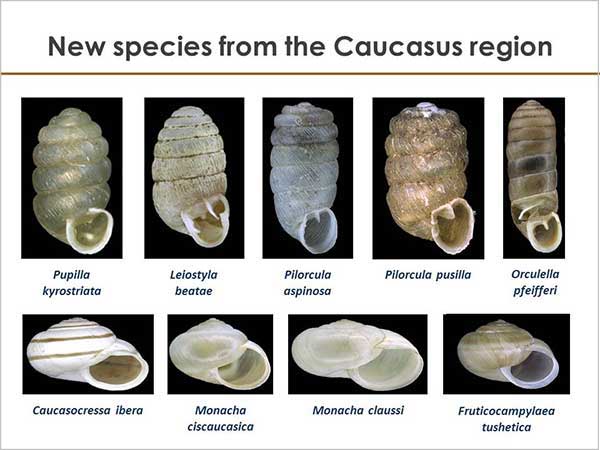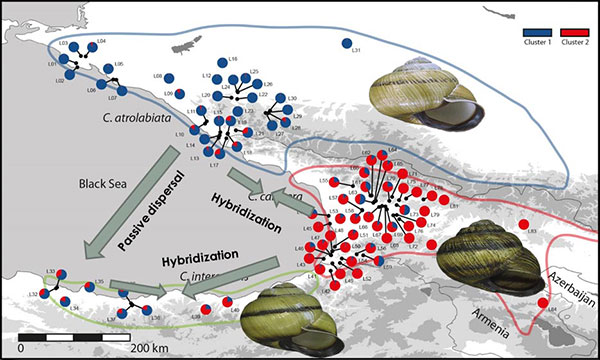Biogeography and systematics of the land snails of the Caucasus Region
The Caucasus region is one of the 25 most species-rich regions of the world, which is seriously threatened by environmental changes. There are more than 300 land snail species known from this region, 66% of which are endemic. In this project, we are investigating the distribution of this diversity and its origins. Together with other curators, we catalogued the material in the most important collections in the museums in St. Petersburg, Moscow, Yerevan, Tbilisi, Frankfurt, Hamburg, Warsaw and Zurich and supplemented it with additional material obtained during expeditions to Russia, Georgia, Armenia and Azerbaijan. On these expeditions also new species were discovered. These were described and problematic groups were systematically revised. The evolution and biogeographical history of model groups could be reconstructed by phylogenetic and biogeographical analyses. Phylogenetic analyses have identified centres of genetic diversity in which the fauna has survived the Pleistocene ice ages. In one case it was shown that hybridization has led to the emergence of a new species. Other factors that affect speciation and the distribution of biodiversity are still under investigation. Based on the distribution data collected in the project, we can assess which species are adequately protected by existing nature reserves and in which regions additional reserves would be necessary in order to protect the numerous endemic species.
Doctoral theses Marco T. Neiber and Frank Walther (funded by the Volkswagen Foundation).
- Walther, F. & Hausdorf, B. 2014. Pupilla (Pupilla) kyrostriata n. sp. from Transcaucasia (Gastropoda: Pupillidae). Arch. Molluskenk., 143: 51–56.
- Walther, F., Kijashko, P. V. & Hausdorf, B. 2014. Redescription of Vertigo (Vertigo) nitidula (Mousson, 1876) (Gastropoda: Vertiginidae) from the Caucasus region. Zootaxa, 3872: 75–82.
- Walther, F., Kijashko, P. V., Harutyunova, L., Mumladze, L., Neiber, M. T. & Hausdorf, B. 2014. Biogeography of the land snails of the Caucasus region. Tentacle, 22: 3–5.
- Walther, F. & Hausdorf, B. 2015. Leiostyla beatae n. sp. from eastern Georgia (Gastropoda: Lauriidae). Zootaxa, 3941: 144–148.
- Neiber, M. T. & Hausdorf, B. 2015. Phylogeography of the land snail genus Circassina (Gastropoda: Hygromiidae) implies multiple Pleistocene refugia in the western Caucasus region. Mol. Phylogen. Evol., 93: 129–142.
- Neiber, M. T. & Hausdorf, B. 2015. Molecular phylogeny reveals the polyphyly of the snail genus Cepaea (Gastropoda: Helicidae). Mol. Phylogen. Evol., 93: 143–149.
- Neiber, M. T., Sagorny, C. & Hausdorf, B. 2016. Increased molecular sampling resolves the phylogenetic relationship of ‘Cepaea’ vindobonensis (Pfeiffer, 1828) with the genus Caucasotachea Boettger, 1909 (Gastropoda: Pulmonata: Helicidae). J. Zool. Syst. Evol. Res., 54: 40–45.
- Koch, E. L., Neiber, M. T., Walther, F. & Hausdorf, B. 2016. Presumable incipient hybrid speciation of door snails in previously glaciated altitudes in the Caucasus. Mol. Phylogen. Evol., 97: 120–128.
- Walther, F., Neiber, M. T. & Hausdorf, B. 2016. Systematic revision and molecular phylogeny of the land snail genus Fruticocampylaea (Gastropoda: Hygromiidae) from the Caucasus region. – Syst. Biodivers., 14 (1): 32–54.
- Neiber, M. T., Sagorny, C., Sauer, J., Walther, F. & Hausdorf, B. 2016. Phylogeographic analyses reveal Transpontic dispersal in the Caucasotachea atrolabiata complex (Gastropoda: Helicidae). Mol. Phylogen. Evol., 103: 172–183.
- Neiber, M. T. & Hausdorf, B. 2017. Molecular phylogeny and biogeography of the land snail genus Monacha (Gastropoda: Hygromiidae). Zool. Scr., 46: 308–321.
- Neiber, M. T., Razkin, O. & Hausdorf, B. 2017. Molecular phylogeny and biogeography of the land snail family Hygromiidae (Gastropoda: Helicoidea). Mol. Phylogen. Evol., 111: 169–184.
- Mumladze, L., Asanidze, Z., Walther, F. & Hausdorf, B. 2017. Beyond elevation: Testing the climatic variability hypothesis versus Rapoport’s rule in vascular plant and snail species in the Caucasus. Biol. J. Linnean Soc., 121: 753–763.
- Neiber, M. T., Walther, F. & Hausdorf, B. 2018. Phylogeny and reclassification of the Caucasigenini radiation (Gastropoda: Hygromiidae) from the Caucasus region. Zool. Scripta, 47: 54–62.
- Walther, F. & Hausdorf, B. 2018. The identity of Inobseratella Lindholm, 1924 and its type species Clausilia lantzi Lindholm, 1924 (Gastropoda: Clausiliidae) from northeastern Turkey. Malacologia, 62: 189–194.
- Walther, F., Neiber, M. T. & Hausdorf, B. 2018. Systematic revision of the Caucasigenini (Gastropoda: Hygromiidae) from the Caucasus region. – Arch. Molluskenk., 147: 129–169.
- Neiber, M. T., Walther, F. & Hausdorf, B. 2018. Polymorphism of a genital organ under sexual selection in Monacha kuznetsovi from the Caucasus (Gastropoda: Hygromiidae). J. Zool. Syst. Evol. Res., 56: 317–322
- Hausdorf, B., Walther, F. & Neiber, M. T. 2018. Molecular phylogeny and systematics of Acrotoma (Gastropoda: Clausiliidae) from the Caucasus. – Syst. Biodivers., 16: 692–713.
- Suchodoletz, H. von, Richter, C, Walther, F., Bliedtner, M., Eloshvili, M., Losaberidze, L. & Hausdorf, B. 2020. Snail assemblages in Holocene floodplain research – an example from the southern Caucasus. E & G Quaternary Science Journal, 69: 247–260.

On these expeditions also new species were discovered. These were described and problematic groups were systematically revised. The evolution and biogeographical history of model groups could be reconstructed by phylogenetic and biogeographical analyses. Phylogenetic analyses have identified centres of genetic diversity in which the fauna has survived the Pleistocene ice ages. In one case it was shown that hybridization has led to the emergence of a new species. Other factors that affect speciation and the distribution of biodiversity are still under investigation. Based on the distribution data collected in the project, we can assess which species are adequately protected by existing nature reserves and in which regions additional reserves would be necessary in order to protect the numerous endemic species. Based on our extensive data, land snails can serve as model group to identify regions which are also important for the protection of endemic species of other animal and plant groups.


